I. INTRODUCTION
After 42 years of promoting diverse and high quality research, the broader EAA leadership team (at the strategy day of November 7, 2019) expressed a desire to also focus on education, teaching and pedagogical issues. In the EAA member survey conducted in Oct 2019, 565 respondents suggested/ranked services and benefits the EAA could consider. The third ranked among a large set of considerations was “educational materials”.
In addition, it was mentioned during the EAA strategy day in November that most higher education institutions increasingly emphasize the importance of high quality and innovative education. Our student population, student career opportunities and teaching technology are changing. Both senior and junior faculty could therefore benefit from new insights in education/pedagogy.
This note is to discuss the results of the survey administered to 62 EAA members contacted by the task force (often EAA committee members and their direct colleagues) between Feb 24 and March 9, 2020. The survey had two goals:
1. Understanding relevance/importance of education in an academic career in accounting
2. Understanding the need for pedagogical innovation and interest in educational content/skills relevant in accounting
Notice that the survey was conducted right before the Covid-19 lockdown in Europe. The pedagogical innovation demands might have changed since the lockdown due to new digital experiences during the lockdown.
II. SURVEY RESPONDENTS – CHARACTERISTICS
The survey was conducted on 62 respondents who were personally contacted by the members of the task force through the EAA committees and their direct colleagues. The respondents spent a median of 14 minutes on the survey with an interquartile range between [11min, 19 min]. Most questions were answered by all respondents.
Table 1 gives some characteristics of the respondents, who are predominantly from Europe and have on average 18 years of academic experience after obtaining their PhD, and are on average 48 years old. We therefore have more senior colleagues and no PHD students in the survey. Only 16% is untenured (11% with a focus on teaching only) and 34% has a pure teaching position. Of those 34% pure teaching positions: 11% is untenured and 23% is tenured. One third is female, and 70% works in his/her home country and 35% at the alma mater. On average 43% of time is spent on teaching, 29% on research and 24% on admin roles. 53% of the respondents indicate that they had an admin role in the last 3 years: most commonly a program director (accounts for 33% of all respondents), but also head of dept, dean, vice-rector, vice-dean. Time allocated for an admin role varies widely between 5% and 100%, but is mostly between 15% and 30% fte for a program directorship.
Table 1 Survey respondents characteristics
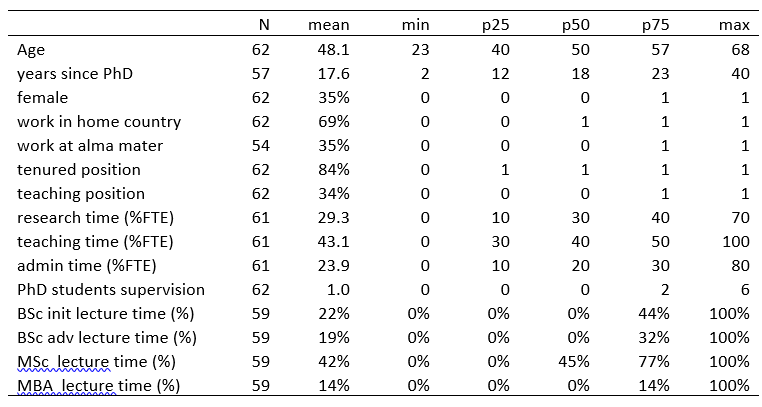
Most of the teaching effort is focused on MSc programs (42% of teaching), 22% is dedicated to initial level BSc, 19% more advanced accounting courses at the BSc level, and finally 14% MBA teaching.
Table 2 provides more information on the schools and universities of the respondents. Notice that the response rate is lower, since not all respondents were familiar with the school data. The most common accreditation is AACSB (68%), which is a mission driven accreditation that also considers innovation and academic career development. 44% of the respondents work in schools with all three major international accreditations (Equis, Amba and Aacsb), called triple crown accreditation.
Table 2 Respondents’ school characteristics
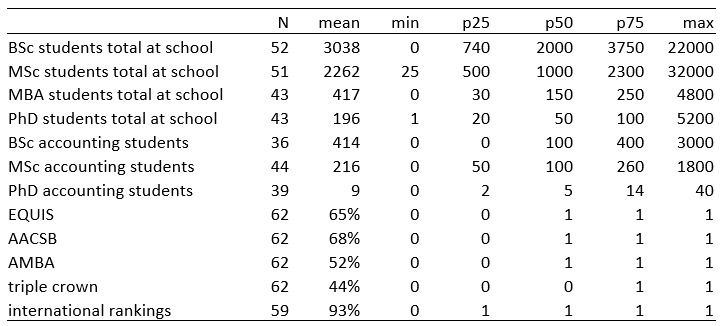
There are some extreme values on the student numbers, for example a school with 5200 PhD students. Medians may give a better view on the school and program sizes. Accounting PhD program have a median of 5 students in accounting out of a total of 50 PhD students in the school (not the university). A median MSc program in accounting has 100 students out of a total of 1000 MSC students at the school level. At the BSc level, some respondents indicated that their school has no concentration in accounting. Overall, the respondents belong to schools that generally care about international accreditations and 93% has internationally ranked programs. Accounting programs and students (BSc, MSc and PhD) represent about 10 to 15% of the school’s student population.
III. EDUCATIONAL INFRASTRUCTURE AND PROMOTION/TENURE POLICY
The educational organization consists of several structural elements that promote improvements and innovation in education: accreditation, training programs, mentoring and annual evaluations.
Figure 1: Educational infrastructure: accreditation, junior and senior faculty training programs and certificates, formal peer mentor program, and an annual faculty evaluation.

Figure 1 shows that the majority of schools obtained an international accreditation to monitor and benchmark their efforts (not only education related). Within this survey, 44% of the schools had all three major international accreditations (AMBA, EQUIS and AACSB).
The vast majority of the schools offer their own educational training programs for junior (85%) and senior (76%) colleagues. That often results in a certificate as a form of recognition.
For junior faculty, the average length of training is between 40 and 50 hours. In 80% of the cases, training sessions are offered once, most likely when the junior faculty member enters the school. For senior faculty, the programs are offered in the form of workshops that can be voluntarily visited. Most schools encourage mentorship by peers, but 61% has this peer mentor program formalized in its faculty development.
Finally, 86% of the schools have an annual faculty review to discuss the performance and development of the faculty member.
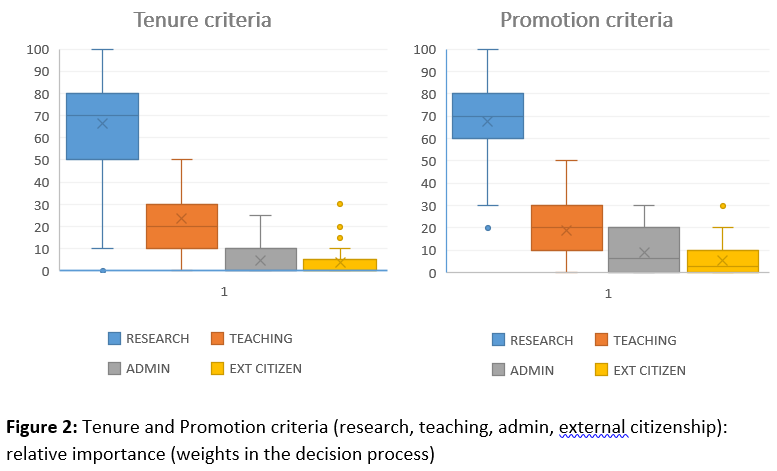
Next, we turn to the promotion and tenure criteria that schools use to incentive the faculty members. The question here is whether schools provide sufficient incnetives to invest in teacghing and educational innovation and management.
Figure 2 shows that the research dimension is the most important criterium for tenure and promotion: on average 67% of the decision weight is based on research versus 23% on education to get tenure and 19% for promotion. Not surprisingly, admin becomes more important for promotion than for tenure, as well as external citizenship (eg: a position in EAA or an editorial board).
When the question was asked whether the respondent would favor a higher weight on the teaching dimension, 67% responded positively. Notice that several schools use specific tracks for pure teaching faculty, and these may significantly lower the research dimension.
Considering these last two points, we believe there is an opportunity for the EAA to offer more education-related content and services to its members, both targeting more research related faculty as well as pure teaching oriented faculty. In addition, senior faculty can often benefit from new educational and pedagogical insights as they less frequently consider training programs at their respective schools.
IV. INNOVATION IN EDUCATION
The traditional classroom was perfectly adequate in the industrial era, when knowledge and skills requirement was largely predictable, society was stable, and progress was relatively slow. Today’s society, by contrast, is changing rapidly due to various factors and today Covid-19 makes it even more disruptive. It is quite irreversible that digitalization is becoming increasingly important in higher education; see Joos & Meijdam (Innovation in higher education: needed and feasible; 2019) for an overview of trends and challenges in innovation in higher education. This section explores innovation and some determinants in order to identify ways EAA could address its members’ needs.
We asked what kind of digital technologies are used out of a set of 10 possibilities (Fig 3).
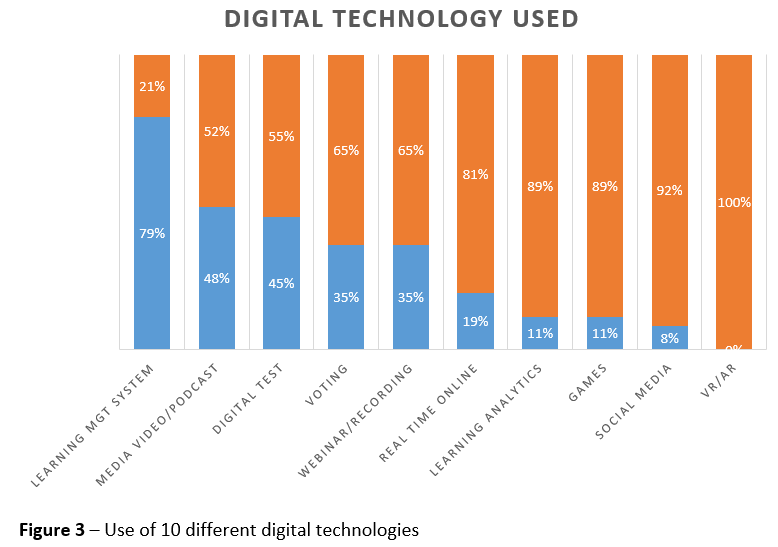
Most colleagues use the learning management system at their school, such as Blackboard, Canvas, Moodle. Also popular is the incorporation of media tools, such as videos, podcasts, pictures etc in the teaching materials. Digital assessments and in-class or online voting/polling is used by 45% of the participants. But before the Covid-19 crisis, only 19% had given pure online (synchronous) lectures, supported with technologies such as ZOOM, MS teams, Cisco Webex. No one is using virtual or augmented reality.
Apart from knowing what technologies are popular, we want to know the total use of the technologies by each user. Figure 4 focuses more on the individual and looks at two aspects: indicate how many technologies you use, and do you consider yourself as an innovator in pedagogy on a scale from 0 to 10 (i.e., perceived innovator).
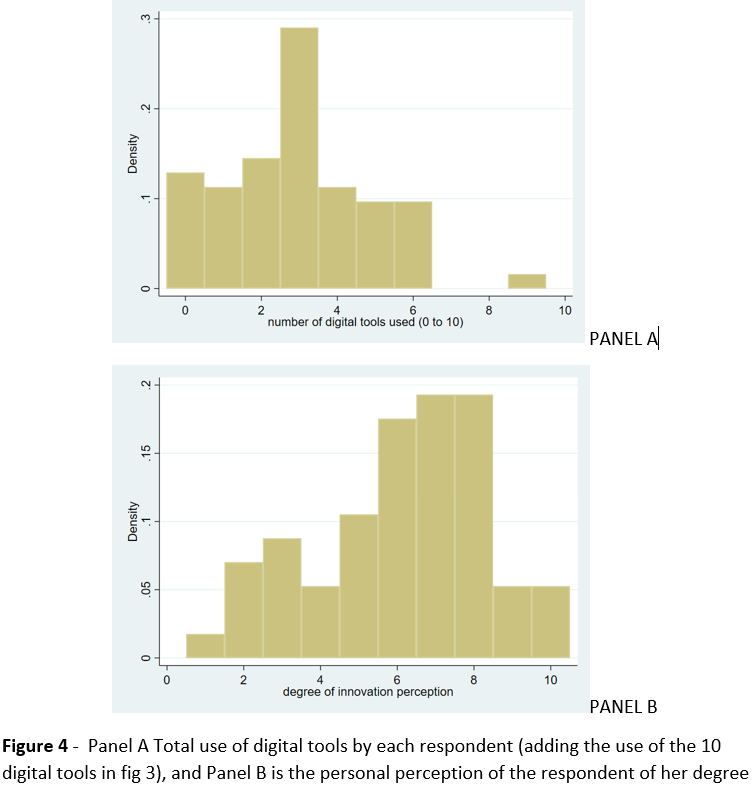
On average (and median) the respondents use 3 technologies and indicate a 6 out of 10 level as perceived innovator. There seems to be sufficient room for improvement on the effective use of digital technologies and sharing experiences.
Next we ask which technologies activate students (open question): The world cloud provides a short overview of answers and shows quite some diversity.
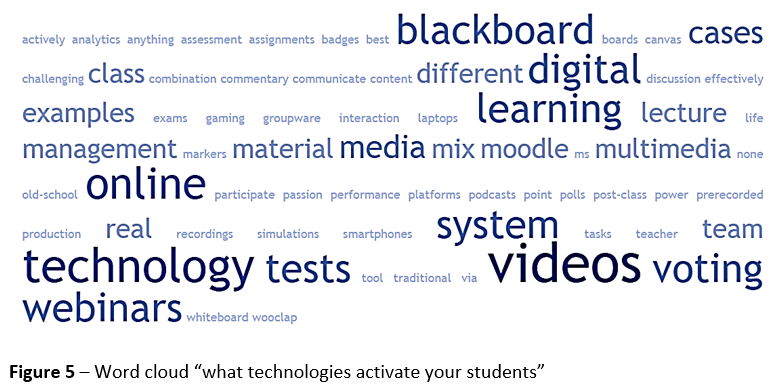
Some respondents refer to analogue activation tools: white board, being a passionate teacher, using contemporary examples and cases. Among the technologies most referenced for activating students: LMS (being a great communication and organization tool), voting and polling software, online quiz, prerecorded videos or webinars.
When asked what technologies are making teaching more efficient, a similar set of answers is provided as shown in figure 5. Here are the most frequent responses: LMS is essential, videos (also class recordings), digital tests, video projectors, and a digital repository (maybe part of an LMS).
Apart from whether instructors use technology in the classroom, we want to know more about specific content or skills that our colleagues require in their courses. We considered a short list of 7 different items that are frequently discussed in the context of education, some related to 21st century skills such as programming skills, ethical awareness and presentation skills. The use of case studies and company visits are linking course content to the real world. Finally, ESG/CSR and technology related topics such as blockchains, software bots and machine learning are trendy topics. Figure 6 shows the results.
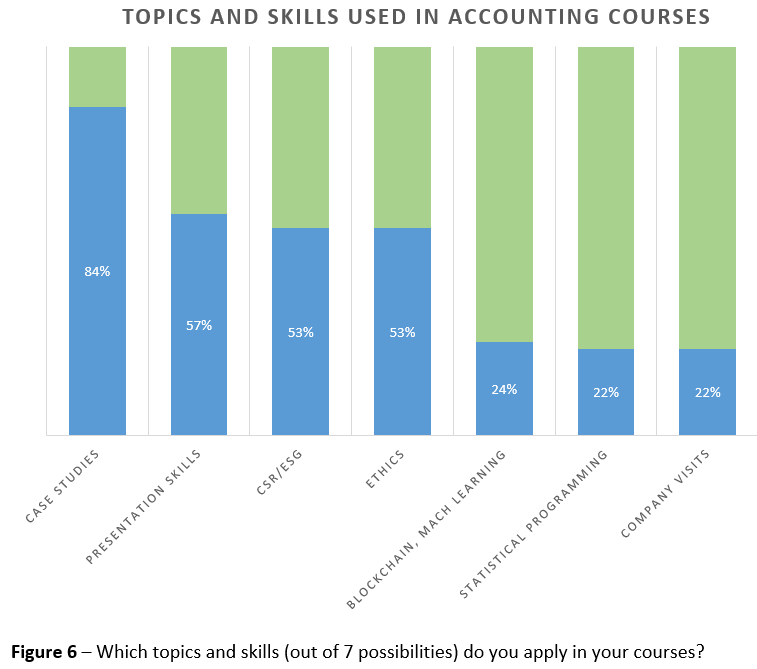
Case studies are by far the most popular tool used in the classroom. Further analysis reveals that cases are used in the following proportion: 60% in BSc courses, 83% in MSc courses, and 87% in MBA courses.
CSR/ESG is addressed by 57% of the respondents in their courses. The following proportions are showing the application of CSR topics at a specific course level: 45% in BSc courses, 57% in MSc courses and 47% in MBA courses. Ethics is not quite the same as CSR/ESG, since there is only a 24% correlation between these two variables. Considering the level at which ethics is introduced, the analysis reveals that 32% of BSc instructors introduce ethics in their course materials, 52% of MSc and 60% of MBA. It is remarkable to observe that ethics is only introduced at a later stage in the education process, namely with master-level students.
Other topics that are mentioned are: external guest speakers and digital simulations.
We next investigate the correlation structure between the personal elements and school features and the level of (perceived) digital innovation. Table 3 shows the correlation between faculty-specific elements and the level of (perceived) innovation.
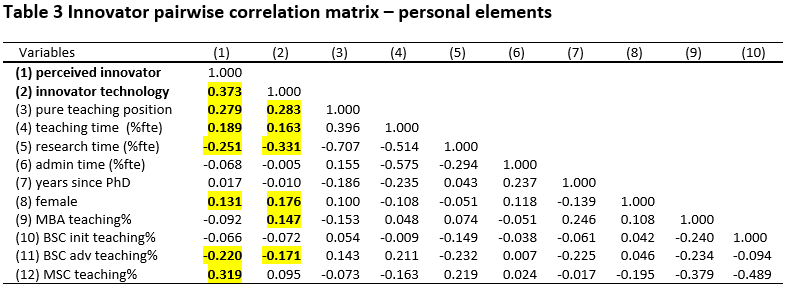
Table 3 shows that the respondent’s perceived level of innovation is positively related to the use of digital tools. Teaching-focused faculty (with a pure teaching appointment and with more time dedicated to teaching) are using more digital tools and perceive themselves as higher level innovators. Faculty with more time dedicated to research are significantly less involved in using digital technology and perceive themselves as lower level innovators.
This signals a potential devide between focusing on content versus delivery method. Although the use of digital technology is not the only way to activate students, it may help an instructor addressing the demands of the new generation of students (more flexibility, more diverse backgrounds, more choice), as well as handling larger student numbers more efficiently. In that sense, new technologies and other students demands are posing an increasing challenge for research-oriented faculty.
Female colleagues are using more digital tools and perceive themselves as higher level innovators. Respondents with a higher time commitment in the MSc programs also perceive themselves as better innovators, unlike thos respondents who teach more at the BSc level in advanced accounting courses.

Table 4 shows how accreditation may contribute to a higher level of (perceived) innovation. AACSB accreditation shows the strongest association with the innovation measures. AACSB is a mission driven accreditation with standards addressing faculty development and innovation. Finally, having a teaching assistant increases the use of digital tools, but has a negative association with the perceived level of innovation. That finding is consistent with the notion that handling digital tools requires an investment and is sometimes time consuming, so additional support by a teaching assistant may help using these tools.
V. CONCLUSION AND NEXT STEPS
Based on a pilot survey conducted in Europe with 62 respondents, we find support for the new strategy of EAA to develop more education oriented activities and services. We surveyed the respondents teaching activities and development, as well as the school’s support and incentive/evaluation system.
We first document that most schools have a heavy emphasis on research in their faculty incentive system for tenure and promotion. Some schools have special teaching tracks. Two thirds of the respondents indicate that more emphasis should be put on education.
Next, we observe that most colleagues use a small set of digital technology tools and do not perceive themselves a high level innovators, although they see a need to revise their courses on a regular basis. The learning management system is the most used tool, together with videos and digital tests. The survey results also show that certain topics, methods and skills (such as ESG, ethics, programming, presentation skills, and case studies) are used in different degrees, and might provide opportunities for EAA to assist its members along these topics.
The Covid-19 crisis started immediately after the survey results were obtained. In a matter of months, our academic community was seriously disrupted and we all had to rely on digital tools for communication, meetings and teaching. It is expected that this digital disruption will continue.
Therefore the education taskforce will do the following:
Start developing online accounting education workshops that cater to education needs of our members. The first workshop will be held on June 19 on “Challenges and Opportunities for Online Accounting Education” with Nieves Navarra and Marco Trombetta. The first time slot (11.30-13.00) is already fully booked, but the extra slot (13.30-15.00) is open for registration. Here is the registration link.
The EAA ARC is seen as the ideal platform to further develop an accounting education repository (of blogs, video content, etc.). Online workshops can be recorded and also made available.
The task force will start to form an EAA education committee and is soliciting candidates. We are looking for colleagues with a proven track record in educational innovation who want to serve for a 2 or 3 year period in this new EAA education committee. Education committee members will be approved by the EAA Management Committee. If you or one of your colleagues (potentially a teaching focused faculty member) have an interest, please send a motivation and current CV to Philip Joos (philjoos@tilburguniversity.edu) before June 30, 2020.
Education Task Force: Philip Joos. Salvador Carmona, Nicholas McGuigan & Seppo Ikaheimo
June 3, 2020
[The full document in PDF is available in the ARC Repository]